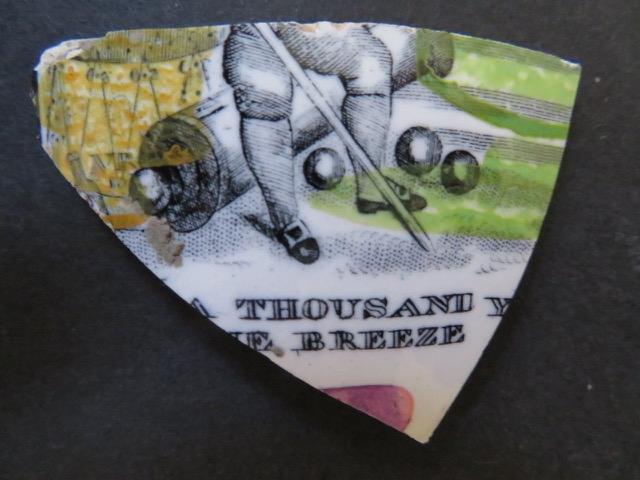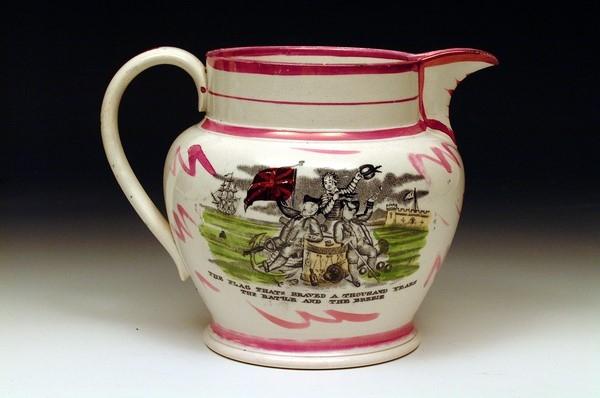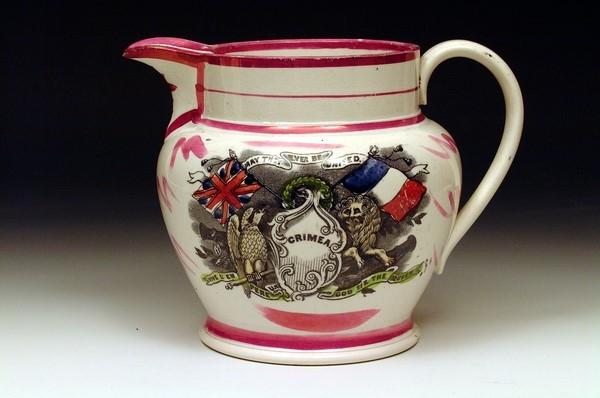Fascinating fragments: A piece of Sunderland Lusterware
In our latest FROG Blog, Rosie Barker delves into the background of a piece of transferware pottery she found on the foreshore recently.
While it’s rewarding to find a complete artefact on the foreshore, I relish fragments, the missing details charge my curiosity.
So when I found this small fragment of Sunderland pink lusterware with its transfer-printed design and lettering my interest was whipped-up.

Googling what remained of the text, I found it to be from a poem or ballad by Thomas Campbell:
YE Mariners of England
That guard our native seas!
Whose flag has braved a thousand years
The battle and the breeze!
In the rhyme, Campbell lauds the role of England’s navy in keeping Britain safe from invasion over many years and the bravery of past heroes. He names two: the Admirals Blake and Nelson. The Union Jack is described as the ‘glorious standard’ launched to meet the enemy. He also states, in his last stanza, that he longs for ‘the star of peace’ to return.
So much for the text, but what with the image? Whose bottom half? His stance and attire suggested someone of importance and the adjacent ‘furniture’ denoted military connections.
Time for further research…
I couldn’t immediately find this image on the Internet, so I emailed Sunderland Museum which has the most extensive collection of Sunderland lusterware. And they sent me this.

Complete jug
Well, as you can see, there were three men! The man whose bottom half features on the fragment has a patch over one eye and on closer inspection the lower part of his arm isn’t visible. Yes, Admiral Lord Nelson. The man sitting astride an anchor, another amputee, is almost certainly Admiral Robert Blake; a young Jack-tar completes the trio. Fluttering in the breeze is the Union Jack.
It’s difficult to see what each is holding: Blake is waving a tankard, Nelson a pipe and more obviously, the jolly Jack-tar is raising his hat in a triumphant gesture – but I’m unsure what is in his other hand.
I was so intent on solving the mystery of the half-man seated on the cannon I’d omitted to ask about any other transfer images on the jug. This was on the reverse:

Whereas I had thought the jug was intended as a general morale booster this links it firmly the successful naval alliance between England and France during the Crimean War. The banner above the shield reads, ‘May they ever be united’ and the banner below, ‘Vive l’empereur ‘and ‘God Save the Queen’.
Campbell’s poem predated the Crimean War but was a perfect choice both because it lauds Britain’s naval prowess and celebrates the end of the war.
The Sunderland Museum jug was made in Scott’s Pottery, Southwick, Sunderland between 1855 and 60 and is in on display in the museum’s Pottery Gallery. Other similar jugs – also plates and bowls are extant, featuring one or both designs. This bowl, not linked to the Crimea, is also on display in the Pottery Gallery.
